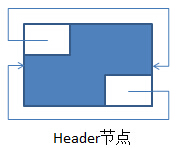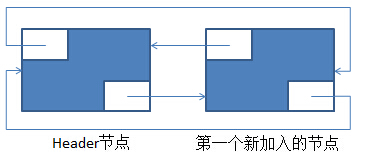LinkedList源码解析
来源:互联网 发布:淘宝网dota2 编辑:程序博客网 时间:2024/06/01 08:12
原文地址:http://www.cnblogs.com/java-zhao/p/5105575.html
一、对于LinkedList需要掌握的八点内容
- LinkedList的创建:即构造器
- 往LinkedList中添加对象:即add(E)方法
- 获取LinkedList中的单个对象:即get(int index)方法
- 修改LinkedList中的指定索引的节点的数据set(int index, E element)
- 删除LinkedList中的对象:即remove(E),remove(int index)方法
- 遍历LinkedList中的对象:即iterator,在实际中更常用的是增强型的for循环去做遍历
- 判断对象是否存在于LinkedList中:contain(E)
- LinkedList中对象的排序:主要取决于所采取的排序算法(以后讲)
二、源码分析
2.1、LinkedList的创建
实现方式:
List<String> strList0 = new LinkedList<String>();源代码:在读源代码之前,首先要知道什么是环形双向链表,参考《算法导论(第二版)》P207
private transient Entry<E> header = new Entry<E>(null, null, null);//底层是双向链表,这时先初始化一个空的header节点 private transient int size = 0;//链表中的所存储的元素个数 /** * 构造环形双向链表 */ public LinkedList() { header.next = header.previous = header;//形成环形双向链表 }
Entry是LinkedList的一个内部类:
/** * 链表节点 */ private static class Entry<E> { E element; //链表节点所存储的数据 Entry<E> next; //当前链表节点的下一节点 Entry<E> previous; //当前链表节点的前一个节点 Entry(E element, Entry<E> next, Entry<E> previous) { this.element = element; this.next = next; this.previous = previous; } }
执行完上述的无参构造器后:形成的空环形双向链表如下:

其中,左上角为previous,右下角为next
2.2、往LinkedList中添加对象(add(E e))
实现方式:
strList0.add("hello");源代码:
/** * 在链表尾部增加新节点,新节点封装的数据为e */ public boolean add(E e) { addBefore(e, header);//在链表尾部增加新节点,新节点封装的数据为e return true; }
/* * 在链表指定节点entry后增加新节点,新节点封装的数据为e */ private Entry<E> addBefore(E e, Entry<E> entry) { Entry<E> newEntry = new Entry<E>(e, entry, entry.previous); newEntry.previous.next = newEntry;//新节点的前一个节点的下一节点为该新节点 newEntry.next.previous = newEntry;//新节点的下一个节点的前一节点为该新节点 size++; //链表中元素个数+1 modCount++; //与ArrayList相同,用于在遍历时查看是否发生了add和remove操作 return newEntry; }
在添加一个元素后的新环形双向链表如下:

在上述的基础上,再调用一次add(E)后,新的环形双向链表如下:

这里,结合着代码注释与图片去看add(E)的源代码就好。
注意:在添加元素方面LinkedList不需要考虑数组扩容和数组复制,只需要新建一个对象,但是需要修改前后两个对象的属性。
2.3、获取LinkedList中的单个对象(get(int index))
实现方式:
strList.get(0);//注意:下标从0开始
源代码:
/** * 返回索引值为index节点的数据,index从0开始计算 */ public E get(int index) { return entry(index).element; }
/** * 获取指定index索引位置的节点(需要遍历链表) */ private Entry<E> entry(int index) { //index:0~size-1 if (index < 0 || index >= size) throw new IndexOutOfBoundsException("Index:"+index+", Size:"+size); Entry<E> e = header;//头节点:既作为头节点也作为尾节点 if (index < (size >> 1)) {//index<size/2,则说明index在前半个链表中,从前往后找 for (int i = 0; i <= index; i++) e = e.next; } else {//index>=size/2,则说明index在后半个链表中,从后往前找 for (int i = size; i > index; i--) e = e.previous; } return e; }
注意:
- 链表节点的按索引查找,需要遍历链表;而数组不需要。
- header节点既是头节点也是尾节点
- 双向链表的查找,先去判断索引值index是否小于size/2,若小于,从header节点开始,从前往后找;若大于等于,从header节点开始,从后往前找
- size>>1,右移一位等于除以2;左移一位等于乘以2
2.4、修改LinkedList中指定索引的节点的数据:set(int index, E element)
使用方式:
strList.set(0, "world");
源代码:
/** * 修改指定索引位置index上的节点的数据为element */ public E set(int index, E element) { Entry<E> e = entry(index);//查找index位置的节点 E oldVal = e.element;//获取该节点的旧值 e.element = element;//将新值赋给该节点的element属性 return oldVal;//返回旧值 }
注意:entry(int index)查看上边
2.5、删除LinkedList中的对象
2.5.1、remove(Object o)
使用方式:
strList.remove("world")源代码:
/** * 删除第一个出现的指定元数据为o的节点 */ public boolean remove(Object o) { if (o == null) {//从前往后删除第一个null //遍历链表 for (Entry<E> e = header.next; e != header; e = e.next) { if (e.element == null) { remove(e); return true; } } } else { for (Entry<E> e = header.next; e != header; e = e.next) { if (o.equals(e.element)) { remove(e); return true; } } } return false; }
/* * 删除节点e */ private E remove(Entry<E> e) { //header节点不可删除 if (e == header) throw new NoSuchElementException(); E result = e.element; //调整要删除节点的前后节点的指针指向 e.previous.next = e.next; e.next.previous = e.previous; //将要删除元素的三个属性置空 e.next = e.previous = null; e.element = null; size--;//size-1 modCount++; return result; }
注意:
- header节点不可删除
2.5.2、remove(int index)
使用方式:
strList.remove(0);
源代码:
/** * 删除指定索引的节点 */ public E remove(int index) { return remove(entry(index)); }
注意:
- remove(entry(index))见上边
- remove(Object o)需要遍历链表,remove(int index)也需要
2.6、判断对象是否存在于LinkedList中(contains(E))
源代码:
/** * 链表中是否包含指定数据o的节点 */ public boolean contains(Object o) { return indexOf(o) != -1; }
/** * 从header开始,查找第一个出现o的索引 */ public int indexOf(Object o) { int index = 0; if (o == null) {//从header开始,查找第一个出现null的索引 for (Entry e = header.next; e != header; e = e.next) { if (e.element == null) return index; index++; } } else { for (Entry e = header.next; e != header; e = e.next) { if (o.equals(e.element)) return index; index++; } } return -1; }
注意:
- indexOf(Object o)返回第一个出现的元素o的索引
2.7、遍历LinkedList中的对象(iterator())
使用方式:
List<String> strList = new LinkedList<String>(); strList.add("jigang"); strList.add("nana"); strList.add("nana2"); Iterator<String> it = strList.iterator(); while (it.hasNext()) { System.out.println(it.next()); }
源代码:iterator()方法是在父类AbstractSequentialList中实现的,
public Iterator<E> iterator() { return listIterator(); }
listIterator()方法是在父类AbstractList中实现的,
public ListIterator<E> listIterator() { return listIterator(0); }
listIterator(int index)方法是在父类AbstractList中实现的,
public ListIterator<E> listIterator(final int index) { if (index < 0 || index > size()) throw new IndexOutOfBoundsException("Index: " + index); return new ListItr(index); }
该方法返回AbstractList的一个内部类ListItr对象
ListItr:
private class ListItr extends Itr implements ListIterator<E> { ListItr(int index) { cursor = index; }
上边这个类并不完整,它继承了内部类Itr,还扩展了一些其他方法(eg.向前查找方法hasPrevious()等),至于hasNext()/next()等方法还是来自于Itr的。
Itr:
private class Itr implements Iterator<E> { int cursor = 0;//标记位:标记遍历到哪一个元素 int expectedModCount = modCount;//标记位:用于判断是否在遍历的过程中,是否发生了add、remove操作 //检测对象数组是否还有元素 public boolean hasNext() { return cursor != size();//如果cursor==size,说明已经遍历完了,上一次遍历的是最后一个元素 } //获取元素 public E next() { checkForComodification();//检测在遍历的过程中,是否发生了add、remove操作 try { E next = get(cursor++); return next; } catch (IndexOutOfBoundsException e) {//捕获get(cursor++)方法的IndexOutOfBoundsException checkForComodification(); throw new NoSuchElementException(); } } //检测在遍历的过程中,是否发生了add、remove等操作 final void checkForComodification() { if (modCount != expectedModCount)//发生了add、remove操作,这个我们可以查看add等的源代码,发现会出现modCount++ throw new ConcurrentModificationException(); } }注:
- 上述的Itr我去掉了一个此时用不到的方法和属性。
- 这里的get(int index)方法参照2.3所示。
三、总结
- LinkedList基于环形双向链表方式实现,无容量的限制
- 添加元素时不用扩容(直接创建新节点,调整插入节点的前后节点的指针属性的指向即可)
- 线程不安全
- get(int index):需要遍历链表
- remove(Object o)需要遍历链表
- remove(int index)需要遍历链表
- contains(E)需要遍历链表
- linkedList 源码解析
- LinkedList源码解析
- LinkedList源码解析
- LinkedList源码解析
- LinkedList源码解析
- LinkedList源码解析
- ArrayList LinkedList源码解析
- LinkedList源码解析
- LinkedList源码解析
- LinkedList源码解析
- LinkedList集合源码解析
- LinkedList源码解析
- LinkedList源码解析
- LinkedList源码解析
- LinkedList源码解析
- LinkedList源码解析
- 从源码解析LinkedList
- LinkedList源码解析
- 什么是MII、GMII、RMII、SGMII、XGMII、XAUI、Interlaken
- Ubuntu配置Samba共享文件
- HTTP协议详解
- git 使用方法
- https自签名证书验证相关代码
- LinkedList源码解析
- 工作日常Bug之——':app:transformClassesWithJarMergingForSelfDebug'.
- 设计模式拾荒之中介者模式(Mediator Pattern): 避免对象间错综复杂的相互引用
- 谕神的密码
- Mediator模式
- 监听启动不成功
- asp.net 利用NPOI导出Excel通用类
- mysql 相关问题
- ANDROID音频系统散记之五:如何绕开多媒体音轨的重采样



